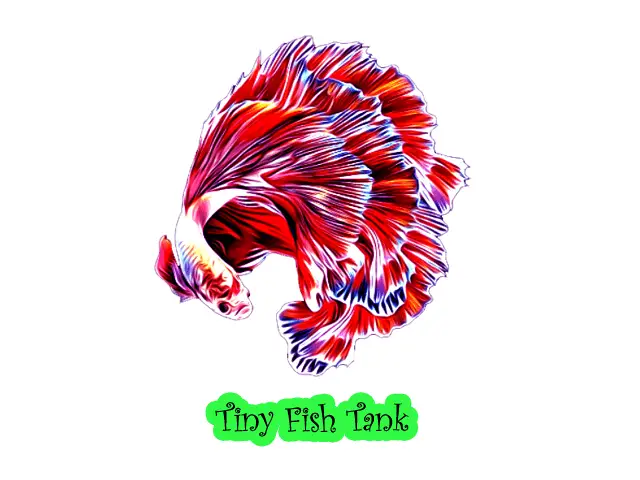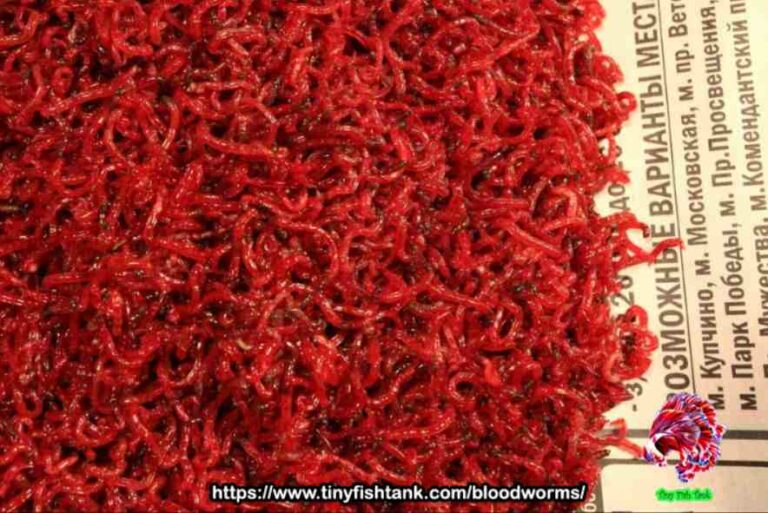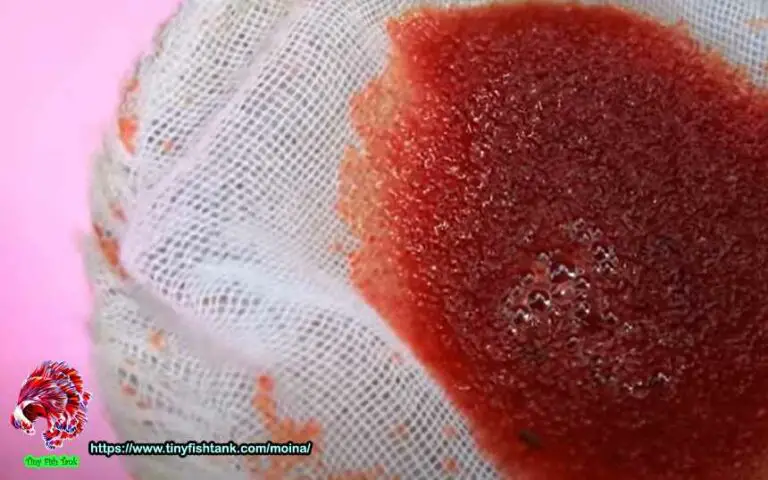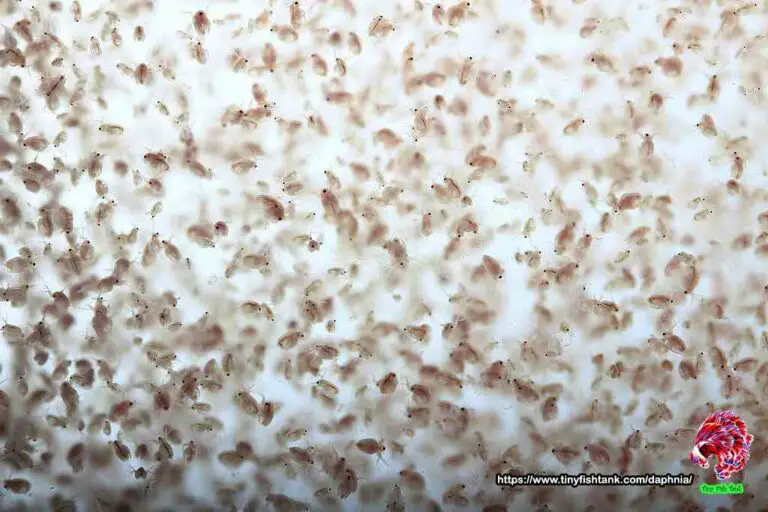Tubifex -The Facts of Aquatic Worms
Most people may never have heard of the Tubifex worm, and its ecological importance cannot be underestimated. From their ability to thrive in polluted waters to their contribution as a bio-indicator of environmental health, these small, skinny worms significantly impact the ecosystems they inhabit.
The Tubifex worms are mainly found in freshwater lakes, ponds, and slow-flowing rivers, where they burrow into sediments. The physical appearance of Tubifex worms is a long, skinny body ranging from a few centimeters to several inches in length.
One of the most fascinating aspects of Tubifex worm development is its adaptation to various environmental conditions. These worms can live in both fresh and polluted waters.
As Tubifex worms consume organic matter, they excrete nutrient waste, further promoting microbial growth. Microbes, such as bacteria and fungi, play a crucial role in breaking down complex organic compounds into simpler forms. Plants and other organisms can easily absorb these compounds.
In agriculture, Tubifex worms contribute to soil fertility and nutrient cycling in aquatic plant cultivation. The nutrient-rich casts left behind by these worms enhance soil structure and provide valuable organic matter for plant growth. Some innovative agricultural practices have integrated Tubifex into aquaponic systems.
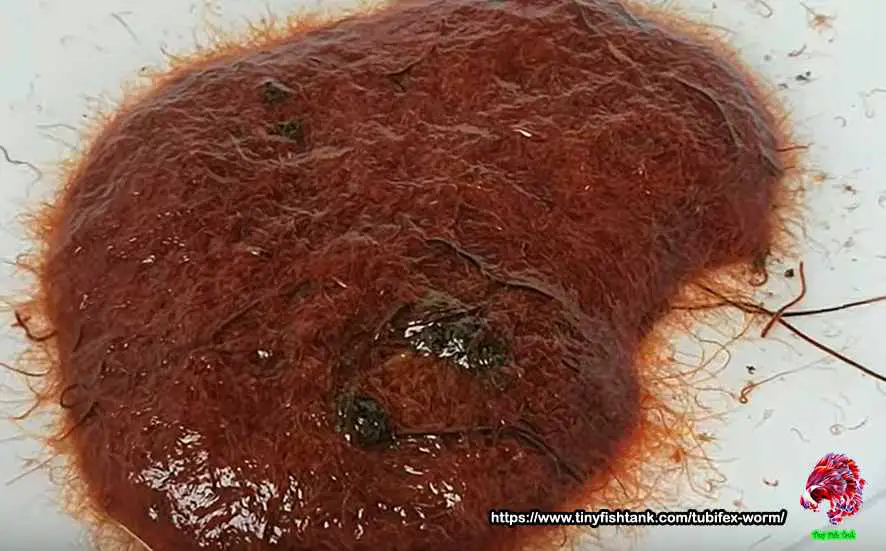
Table of Contents
- History and Anatomy of Tubifex Worms
- Helps to Ecosystem Balance
- Tubifex Worm Body Structure
- Tubifex life cycle and reproduction
- Tubifex Worm’s Diet
- Nutritional Value of Tubifex Worms
- Tubifex worm types available in the market
- Tubifex Worms Use Fish Bait
- Parasites and Predators of Tubifex Worms
- What are the alternatives to Tubifex worms?
- Frequent ask questions and answers
History and Anatomy of Tubifex Worms
Tubifex worms are known as sludge worms, sewage worms, Tubifex spp, or simply tubificids. Their existence was first documented in the mid-18th century when scientists began to study aquatic microorganisms.
The year was 1827 when the scientific community first saw these mysterious worms. A German zoologist Johann Wilhelm Zetterstedt noticed a strange worm population in the muddy sediments of freshwater habitats. Initially confused by their appearance, Zetterstedt brought back samples of these worms to his laboratory for further examination.
The strict classification process began, and the worms were assigned to the Tubificidae family, a group of small, oligochaete worms. Tubifex worm intrigue does not end with their physical attributes. With numerous species identified within the Tubifex genus, taxonomists have faced challenges in accurately classifying and naming these worms.
Taxonomy, pioneered by “Carl Linnaeus” in the 18th century, is the science of identifying, describing, and classifying organisms based on shared characteristics. Later, they were officially named “Tubifex,” inspired by their tube-like appearance and behavior.
The genus Tubifex belongs to the larger family Naididae, which encompasses a mixed group of aquatic worms. Over time, numerous species have been attributed to the Tubifex genus, leading to various names for these worms.
As scientific methods advanced, researchers learned that some species originally classified as Tubifex were, in fact, different enough to warrant their genera. However, with improvements in DNA sequencing and phylogenetic analyses, scientists have resolved some taxonomic uncertainties.
However, despite their importance in the ecological balance of these ecosystems, Tubifex worms have remained relatively unknown to the general public.
Helps to Ecosystem Balance
Tubifex worm’s role in nutrient cycling and decomposition contributes to aquatic ecosystem health. Their activities encourage the breakdown of organic matter, recycling nutrients essential for aquatic plants and other organisms. This ecological service helps to maintain the delicate balance of these habitats and confirms the maintenance of various aquatic species.
The breakdown of complex organic compounds into simpler forms ensures that essential elements like carbon, nitrogen, and phosphorus are readily available to other organisms, including plants and algae.
Tubifex Worm Body Structure
Located at the anterior end, the head of a Tubifex worm is relatively featureless, lacking eyes and a well-defined mouth. Instead, they possess a specialized structure known as the prostomium, which aids in burrowing and sensing their environment. This sensory organ enables them to detect water currents and potential food source changes.
Their cylindrical shape is perfectly adapted to life in freshwater sediments, where they burrow and construct intricate tunnel networks. This underground lifestyle allows them to seek shelter from predators and find ample food resources.
These organisms display remarkable resilience and adaptability, thriving in environments where other species struggle to survive. Tubifex worms can tolerate low oxygen levels, high organic pollutants, and extreme temperature fluctuations, setting them apart from other aquatic organisms. It is this unique set of characteristics that makes Tubifex worms scientifically fascinating.
The average size of Tubifex ranges from 0.20 inches (5mm) to 1.50 inches (38.10mm) in length. Sometimes, they can grow up to more than 2 inches, and their size depends on their age and environmental conditions.
When considering the pH level of the water, Tubifex worms need a range of around 6.5 to 7.8 to live, but they can tolerate a broader pH range, typically between 6.0 to 8.0. Additionally, the ideal temperature for their survival is usually between 50°F (10°C) to 77°F (25°C).
Tubifex life cycle and reproduction
Tubifex worm life cycle and reproduction have amazing facts, and the most unique adaptation is its ability to resist extreme environmental fluctuations. They have shown incredible tolerance for temperature variations, from cold waters to scorching hot temperatures. This flexibility enables them to inhabit various regions, from polar areas to tropical climates, proving their adaptability and solidity.
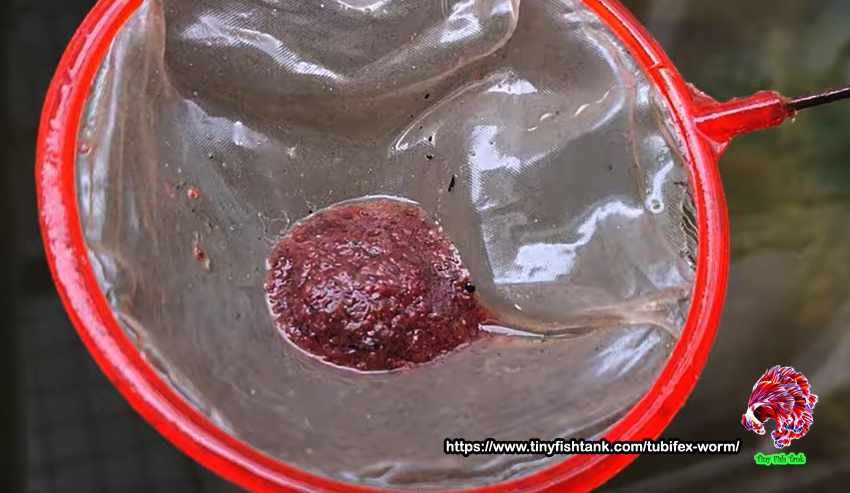
Tubifex worms have developed unique physiological adaptations to live in low-oxygen environments. Through specialized respiration methods, such as cutaneous respiration, they can extract oxygen directly from the surrounding water and even through the thin walls of their burrows. This ability allows them to survive in stagnant or polluted waters, where other organisms struggle.
Furthermore, Tubifex worms indicate unique reproductive strategies as part of their survival adaptations. Their ability to reproduce sexually and asexually allows for rapid population growth and colonization of new habitats. Their small size and high reproductive output make them incredibly successful at establishing and maintaining populations in various environments.
The slimy mucus allows Tubifex worms to glide smoothly through water and sediment, reducing conflict and enhancing movement efficiency. This mucus secretion also aids in the construction and maintenance of their burrows, providing their sanctuary in the sediment.
Sexual reproduction
During the sexual reproduction, these worms engage in courtship patterns, where they release pheromones to attract potential mates. Once a proper partner is found, they intertwine their bodies in a dance of fertilization, ensuring the successful transfer of gametes.
Following successful fertilization, Tubifex worms produce tiny, lemon-shaped cocoons that house their developing embryos. These cocoons are laid in the sediment, protecting against predators and environmental fluctuations. As the embryos mature within the cocoon, they undergo a series of developmental stages, eventually hatching into juvenile worms, ready to explore their new aquatic home.
Asexual reproduction
Asexual reproduction, specifically through fragmentation, also plays a notable role in Tubifex worm population dynamics. In this process, a piece of the worm can separate itself and regenerate into a complete individual. This ability allows for rapid reproduction and colonization of new habitats, contributing to their success as flexible and resilient organisms.
Tubifex Worm’s Diet
Tubifex worms are detritivores, meaning a Tubifex worm’s diet is decaying rotting matter found in aquatic sediments. Their diet includes algae, bacteria, plant debris, dead animals, and other organic materials that settle at the bottom of lakes, rivers, and ponds. As these worms consume and process this detritus, they break down complex organic compounds into simpler forms, facilitating nutrient recycling.
One of the most fascinating aspects of Tubifex’s feeding behavior is its use of a mucous net. These worms secrete a sticky, mucus-like substance that traps suspended particles in the water. Positioning themselves in the water column and undulating their bodies creates a current that carries food particles toward their mucous net. This creative feeding strategy allows them to capture and consume food in low-nutrient environments efficiently.
Tubifex worms’ feeding habits are not limited to detritus. Tubifex worms also reveal opportunistic behavior, readily consuming small organic matter, microscopic organisms, and even each other when an opportunity arises. This adaptability to their diet allows them to survive in various conditions, making them ecological pioneers in fresh and polluted waters.
Tubifex worms have adapted to these challenges by having flexible feeding strategies. They can adjust their feeding rates and preferences based on food sources availability, ensuring their survival even in dynamic environments.
Nutritional Value of Tubifex Worms
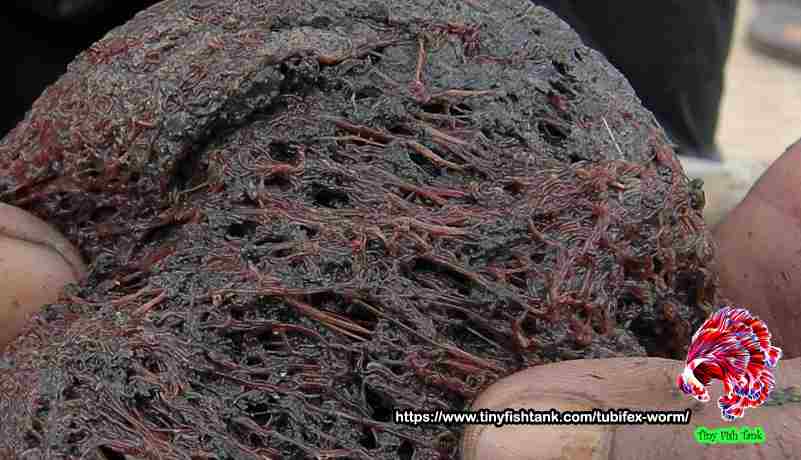
Tubifex worms are relatively small but have nutritional value for many other aquatic organisms. Their bodies are rich in proteins, lipids, and essential amino acids, making them a valuable food source for aquatic species. These worms are often used in aquaculture to supplement fish and other organisms’ diets.
Tubifex nutritional value table
| Nutrient | Value |
| Calories | 50% |
| Protein | 12% |
| Fat | 5% |
| Carbohydrates | 3% |
| Fiber | 2% |
| Calcium | 5% |
| Iron | 2% |
| Magnesium | 20% |
| Sodium | 1% |
Tubifex worm types available in the market
- Live tubifex worms
If you want live tubifex worms, you can buy them near the pet shop and keep them for 2 -3 days maximum. After that, they will die due to lack of food and other things. Live tubifex worms contain high protein value comparing dried worms. When you feed live worms into your aquarium, you will see floating few mints and sink them into the bottom.
- Frozen tubifex worms
Frozen tubifex worms are also available in the pet shop and are dead worms. These frozen worms need to store in the freezer, and you can keep them until 20 -25 days. If your seller packs worms properly, you can keep them until 30 days maximum. Frozen worms come as cubes, and when you feed them to the aquarium, you will see them sink into the bottom of the tank after a couple of mints.
- Dried tubifex worms
Dried tubifex worms are the easiest to buy and feed to fish because they have already died and dried well. So you can keep them until 90 days maximum without any problem. Make sure to lid close properly in the bottle once you use it. You can store it at room temperature, and no need to keep it in the fridge. Dried tubifex worms contain less nutritional value comparing Live tubifex worms.
Tubifex Worms Use Fish Bait
Tubifex worms have gained popularity as fish bait in the fishing industry due to their availability, ease of use, and attractiveness to various fish species. However, their use as bait comes with both advantages and disadvantages. We explore the pros and cons of using Tubifex worms as fish bait and their importance to aquatic ecosystems and fishing practices.
Pros of Tubifex Worms as Fish Bait
1. Attractiveness: Tubifex worms emit a distinct odor that attracts many fish species. Their energetic movements and natural appearance in the water make them an enticing choice for anglers.
2. Versatility: These worms are suitable for various fishing techniques, including float fishing, bottom fishing, and feeder fishing, making them a versatile option for different fishing scenarios.
3. Easy Availability: Tubifex worms are readily available in many bait shops and pet stores, making them a convenient and accessible bait option for anglers.
5. Cost-Effective: Compared to other live baits, Tubifex worms are relatively cheap, making them an economical option for anglers on a budget.
Cons of Tubifex Worms as Fish Bait
1. Spreading Diseases: Tubifex worms carry parasites and diseases that can be transmitted to fish and other aquatic organisms.
2. Non-Native Species Concerns: Tubifex worms may introduce non-native species into the environment in some regions, leading to ecological imbalances.
3. Overharvesting: The high demand for Tubifex worms as bait can lead to overharvesting in natural habitats, potentially affecting local populations and their ecological roles.
Parasites and Predators of Tubifex Worms
Tubifex worm predators and parasites keep the harsh struggle for survival beneath the water’s surface. These natural worms face threats from cunning predators and microscopic parasites, each shaping their population dynamics.
Interestingly, peristalsis enables Tubifex worms to react rapidly to environmental changes. When faced with disturbances or threats, they can quickly retract into their burrows, seeking safety from potential predators. This ability to move with such flexibility allows them to avoid danger and maximize their chances of survival.
One of the primary predators of Tubifex worms is aquatic insects. Predatory insects such as dragonfly nymphs, water beetles, and diving bugs feed on these worms, quickly snatching them from their burrows.
In addition to microscopic predators, Tubifex worms are also helpless to microscopic parasites. These parasites, such as various species of protozoans and nematodes, infest the internal organs of the worms, manipulating them for their survival and reproduction. Parasites weaken Tubifex worm populations, impacting their health and reproductive success.
What are the alternatives to Tubifex worms?
There are many alternatives that you can use instead of tubifex worms. Some other options are cheaper than Tubifex, and some are higher priced. Another important thing is nutrition value, which also changes depending on the alternative food. Here are a few feeds you can buy in the market as alternative feeds.
01. Bloodworms
02. Black worms
03. Manga Daphnia
04. Moina
05. Mosquito Larvae
06. Daphnia
Frequent ask questions and answers
Is Tubifex suitable for saltwater fish?
Yes. They are suitable for saltwater fish too. You can feed them without any problem with saltwater fish.
Will my aquarium fish eat tubifex worms?
If you have omnivores or carnivores types of fish, they will eat tubifex worms without any problem. When algae eat fish, please don’t buy this worm for them. They will not eat live feeds at all.
Are bloodworms and Tubifex worms the same?
No. They are two different types of worms and need two different environments conditional to live too. Bloodworms can live a little bit deep in the water, but Tubifex cannot live in deep water.
Will Chlorine kill Tubifex worm?
Yes. Chlorine is unsuitable for tubifex worms, which will die in chlorine water. So do not provide them with direct Chlorine water; they need polluted muddy water to live merrily.
Why is Tubifex expensive?
Culturing tubifex worms are bit more tricky and costly than you expected. Farmers must spend extra time feeding and monitoring the culture to get the maximum harvest. So that is why tubifex worms are expensive in the market. Even if the seller finds them in a natural live location, the seller needs to put extra effort, time, and cost to clean Tubifex properly. Those are the reason tubifex worms keep expensive in the aqua market.
Where can you find tubifex worms?
You can find them quickly nearest pet shops and aquarium houses. As well as now, you can buy them via online websites. Finding the live Tubifex is a little bit hard comparing dried worms.
Does Tubifex worm Bite?
No. There is no reported bite of tubifex worms in society.
